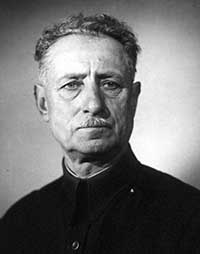Amashukeli Vasil

Vasil (Vaso) Amashukeli (b. March 14, 1886, Kutaisi — d. December 2, 1977, Kutaisi) was the director of the first Georgian documentary film, the first Georgian cinematographer and director, People's Artist of Georgia (1974).
He received his primary education at the Kutaisi Gymnasium (1893-97). He studied at V. Balanchivadze Art School. He started mastering the art of painting in Moscow (Bolshakov School) from 1900. Here, he was fascinated by “live pictures” and became an apprentice of the film mechanic of the “Electric” movie theatre. In 1906, he moved to Baku, continued his studies at the Electrical Technical College, and was soon invited to work as a film technician at the newly opened “Electro-Biograph” movie theatre with the Society for Spreading of Literacy. After completing the course for cinematographers at the Moscow branch of the French firm “Gaumont” (1908–1910), he filmed the following stories: Members of the Society for Spreading Literacy Among Georgians walking on the coast of the Caspian Sea, Actors of the Georgian stage: Efemia Meskhi, Kote Meskhi and others in the City Park, Working on oil wells, Carrying coal with camels, Ship entering the “Caucasus-Mercury”, Views of Baku, Caspian coast, Baku market types, Fisherman by the Caspian Sea , Parade of the Ghunib Regiment on April 25, 1909, Military unit marching in the street and others. In 1909, the owners (T. Asatiani and P. Mepisashvili) of the new movie theatre “Radium” in Kutaisi invited Amashukeli to work there as a film technician. He participated in the establishment of “Radium”, where he worked until 1921. In December, 1910, he finally settled in Kutaisi, and he filmed the chronicles of the city life and its views with “Gaumont” equipment. His film Journey of the Georgian Poet Akaki Tsereteli to Racha-Lechkhumi from July 21 to August 2 in 1912 is a unique example of the world documentary film of that time with its ideological and professional level and length (1200 m). The film displayed Georgian historical monuments and folk traditions (the film was restored in 1954 and 2009). This film laid the foundation for Georgian documentary cinematography. In 1913–1914, Amashukeli filmed several other stories: Military parade in Kutaisi, Farm in village Choma, Gviriloba (traditional public holiday in Kutaisi), Views of Kutaisi, Kutaisi society near the ruins of Bagrati Cathedral, The silk-winding factory of Khoni, Saint Nicholas's day, Georgian cultural figures: Samson Dateshidze, Lado Bzvaneli and others near the hotel “Rioni, Akaki Tsereteli's trip to the villages of Kvemo Imereti, A walk in the city park, Kutaisi Classical Gymnasium and Gymnasium Students, Shore of the Rioni River and others. The short stories filmed by Amashukeli in Baku and Kutaisi have not been found. He lived in Kutaisi until the end of his life and worked as an electrician in the city council.
Literature: ბურდული ჯ., ვასილ ამაშუკელი, თბ., 1977; გოგოძე კ., ვასილ ამაშუკელი, თბ; 1954; შარაძე ნ., „აკაკი წერეთლის მოგზაურობა რაჭა-ლეჩხუმში“, თბ., 2006; ჩხეიძე რ., დოლიძე გ., ვასილ ამაშუკელი, თბ.,1986; „აკაკი წერეთლის მოგზაურობა რაჭა-ლეჩხუმში 1912 წელს“ (მულტიმედიური ალბომი. ავტორები: მ. კერესელიძე, ნ. ნატროშვილი, ნ. ჯანელიძე), თბ., 2009; Гогодзе К., Первый грузинский кинооператор, წგ.: Из историй кино, в. 4, М., 1961.
M. Kereselidze


